Beyond knowing exactly where your vehicle is at any point in time and being able to immobilize a vehicle when situation so demand, fleet management system or telematics produces some results that could fundamentally aid the effectiveness of driver behaviour’s assessment and performance improvement.
Behaviours such as excessive idling, aggressive acceleration, harsh braking, sudden deceleration, over speeding and fast cornering are some unhealthy driver behaviours that could negatively affect safety (of driver, vehicle, cargo and other road users), preventive maintenance schedules and ultimately cost of fleet operation.
Below are some of the things you need to know about these improper driving ethics and how continuous assessment of these behaviours using telematics can help you to improve performance benchmarks:
EXCESSIVE IDLING
You may want to read up our article on Idling for an in-depth understanding of what it is.
However, excessive idling can vary depending on industry and how the vehicle is being used. What may be considered excessive by one organization may be considered routine by another.
It is important for every organization to determine what is appropriate for their specific needs and factor that into an overall assessment of and recommendation for their fleet.
Nonetheless, it is something for every fleet to consider because excessive idling can not only affect fuel consumption but also preventive maintenance schedules.
One estimate suggests that one hour of idle time is equal to approximately 25 miles of driving. Generally, it is recommended that fleets follow the manufacturer’s recommendations for minimum warm-up time.
Additionally, ensuring that you have access to your fleet’s data, establishing an appropriate baseline that reflects your fleet and your industry, and tracking/managing idling time is the best approach.
HOW and WHY excessive idling vary between asset types
Assets and vehicles idling will vary depending on their location and function. For example, delivery vehicles may idle while parked; tractor trailer trucks often idle to maintain a comfortable cab temperature.
Heavy-duty vehicles often carry auxiliary equipment, such as safety lights or aerial lifts that require the truck to idle in order to provide power to that equipment.
And, transit vehicles idle daily while loading and unloading passengers. The best approach for any fleet manager is to determine what the baseline should be for your industry and application and go from there in terms of evaluating your own fleet.
Decreasing Excessive Idling
There are technologies that can help fleets manage idle time. For example, modern vehicles can be programmed to have their engines automatically shut down after a preselected time frame, such as five minutes.
For vehicles in colder climates, electric engine heaters (e.g. block heaters) can minimize idling time as the vehicle warms up. For fleets that have equipment that needs power, installing generators or auxiliary power units is a more efficient alternative to vehicle idling.
While newer technologies can help manage idle time, one of the most effective ways to manage idling is to properly train your drivers. In fact, studies have shown that most drivers underestimate idle time.
Helping drivers to understand the impact of idling on fuel economy and preventive maintenance schedules can go a long way towards managing excessive idling within your fleet.
Fleets should consider proactively implementing a campaign that encourages drivers to turn off the engine when the vehicle is not in motion, and let drivers know that turning the engine off, then back on (even if only for a short time) is not bad for the starter in modern vehicles.
They should also inform drivers with regard to the manufacturer’s recommendations for warm-up time and for cool-down after load operation.
SPEEDING
HOW and WHY speeding vary between asset types
Due to their weight and momentum, excessive speed in vans and trucks is more dangerous because these vehicles are simply harder to stop. And, the consequences of a collision can be more severe with larger vehicles.
The larger the vehicle, the more momentum it has at any given speed. This is why larger vehicles should be driven at less than the posted speed limit. And, for all other vehicles, drivers should be directed to drive within the posted speed limit.
Reducing/Controlling driver speeding
With regard to training, drivers should understand the implications of speed, weight, and momentum. They should also understand the implications of speed with regard to traction — the faster the speed, the less traction a vehicle has.
Training should also emphasize that “excessive speed” not only means exceeding the speed limit, it also means going too fast for the current conditions, even though the vehicle may be traveling less than the speed limit.
Drivers must know how to manage their speed in both good and adverse conditions. It must also be emphasised that even where a Speed Limiter is installed and activated in a particular vehicle, driver must at all-time apply what is called “Commonsense Speed” (The right speed for a given situation and driving conditions).
AGGRESSIVE ACCELERATION, HARSH BRAKING AND SUDDEN DECELERATION
HOW and WHY aggressive acceleration, harsh braking and/or sudden deceleration vary between asset types
While larger vehicles typically do not accelerate as quickly as smaller vehicles due to their greater mass, they generally achieve greater momentum for the same reason, which means the vehicle is harder to stop.
Drivers who may be unaware of this fact can quickly get into trouble with regard to aggressive acceleration and harsh braking or sudden deceleration.
Add to that the tendency of drivers in larger vehicles to have a feeling of invincibility because they are surrounded by such a large machine, and this can lead to more aggressive behaviour.
At the end of the day, acceleration is still a function of driver behaviour and the power of the vehicle and an aggressive driver in a large vehicle (with a lot of power) is just as dangerous as an aggressive driver in a smaller vehicle.
Reducing Aggressive Acceleration
Drivers need to be trained to understand the implication of aggressive driving and how to control their emotions.
Aggressive acceleration is first and foremost a safety issue but it also wastes fuel and adds wear and tear to your vehicles.
Teaching drivers responsible techniques and incorporating them into your overall driver policy is one of the best ways to control aggressive driving behaviour.
FAST CORNERING
HOW and WHY fast cornering vary between asset types
Again, due to their greater mass, larger vehicles have more momentum and typically have a higher center of gravity, so fast cornering can cause the driver to lose control more quickly than in smaller vehicles.
Reducing Fast Cornering
As with most problematic driving behaviours, training is the best solution. Drivers need to be instructed, especially with regard to medium and heavy-duty vehicles, on safe driving techniques.
Larger vehicles need more space to turn and manoeuvre; especially at intersections and with regard to turns. Whatever minimal time is saved by over-accelerating through a turn is not worth the risk that is created by such behaviour.






